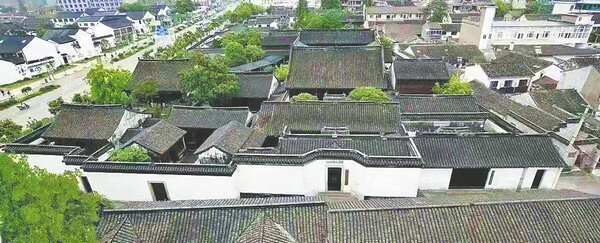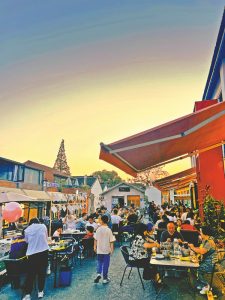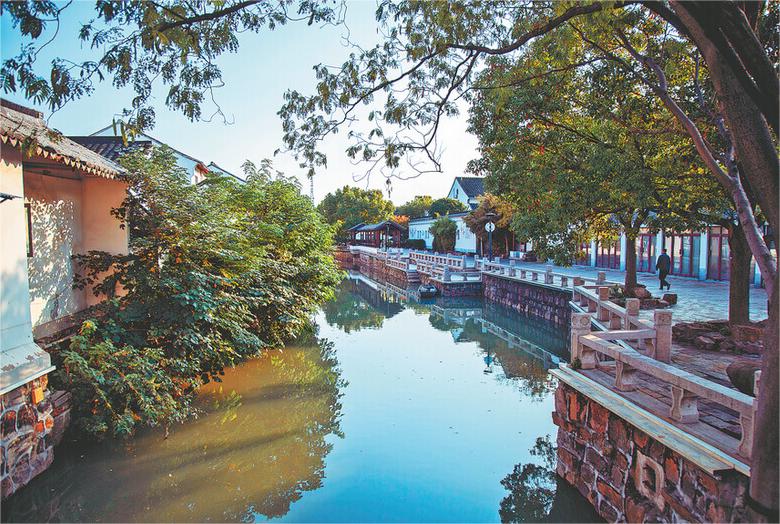
Ancient city is reaping the benefits of long-term regeneration projects, which target historical neighborhoods and dormant industrial sites, Zhang Kun reports in Changshu, Jiangsu.
Changshu, an ancient city with a history of more than 1,700 years, is taking innovative measures to inject new life into its old town.
Located in the south of Jiangsu province, in 1986, Changshu was among the first cities in China to win the title of “a renowned historical city of China”. In 1983, archaeologists uncovered a prehistoric site that showed signs of human activity, including agriculture, which was evidenced by the discovery of carbonated rice grains. The site was proved to be part of the ancient Chinese Songze Culture dating back 5,800-5,300 years. Over the course of millennia, Changshu developed a glorious culture, especially well-known for guqin, a plucked string instrument favored by Chinese literati.
Today, the city still has residential communities of vintage buildings dating back to the early 1900s. While they contribute to the unique urban landscape of the city, many are in poor condition, without modern plumbing or gas fittings, and have long been in a state of disrepair. The protection, restoration and renewal of these historical buildings have been a key issue for the city’s administrators.

In 2016, Xijing’an (or West Creek Bank) community was one of the first neighborhoods named a provincial-level historical block. Today, visitors can still find in the 17.58-hectare neighborhood the former residence of renowned scholar Ding Zuyin (1871-1930), novelist Zeng Pu (1872-1935) and Shen Shiyou (1858-1917), a poet and connoisseur of Chinese ink stones. The elaborately designed buildings and gardens gave the area special significance in the city’s cultural landscape.
However, many old residents have moved out of the area in favor of convenient modern apartment buildings. Some houses have long been deserted and their walls are collapsing. In 2020, the city started a campaign to restore the important historical buildings for modern commercial functions, such as boutique hotels, creative studios, cafes and tea houses.
“A lot of the descendants of the prestigious local families have emigrated,” says Shen Yun, director of the tourism department of Yushan Culture and Tourism Resort Administration. “The right of inheritance for some houses is rather complicated, so legally purchasing these historical buildings for commercial development is almost mission impossible.”
The local administration came up with a novel plan to rent the houses from the owners, signing long-term leases for 20 years. The arrangement was welcomed by the owners, who will receive the rent money on a yearly basis. The administration also developed a house-swapping plan for the elderly people who choose not to leave the neighborhood.
Some of the old houses were refurbished with modern bathrooms and kitchens, the floors were relaid and walls repainted, and were then re-leased to local residents. People living in the community can be an asset for the new commercial project, Shen Yun says. “The smell of home cooking, and grannies sitting in the yard chatting and sunbathing… these will remind tourists of the history of the area and the lifestyle we all had decades ago.”

A retiree, surnamed Xi, and his wife are among those who agreed to such an arrangement, and moved to a refurbished house in the old neighborhood.
“Me and my three siblings grew up nearby. The small lanes and old neighbors are all too familiar to give up,” Xi tells China Daily. Surrounded by the same street corner tea tables, loquat trees and a clear water well that is centuries old, Xi is glad to retain much of his old lifestyle, only without the annoying chore of taking out the chamber pot every morning.
Changshu Gucheng Co Ltd, a State-owned enterprise, is responsible for the restoration and renewal of the vintage buildings and gardens. “The less we change, the better,” says Zhu Guoqing, general manager of the company.
“If a wood column is rotten from the lower end, we will replace the damaged part and join it with a new piece of wood with the traditional tenon and mortise structure,” he says. “We prioritize the protection of the cultural heritage over financial efficiency. The unique local culture and tradition will be the core attraction of the area when it is completed.”
As well as the ongoing Xijing’an neighborhood renewal project is the Shanqianfang compound at the foot of Yushan Mountain. A creative culture industry park transformed from a cluster of deserted factory workshops and warehouses, it has been recognized as a landmark project for urban renewal in Changshu. Inspired by the successful example of Shanqianfang, the city has seen several more creative industry parks and blocks open, Shen says.

Since its official opening on June 18, 2021, Shanqianfang has had more than 50 tenants, among which are restaurants, immersive game centers, jewelry design studios and boutique hotels.
In May, Shanqianfang hosted its first art week, featuring movie projections, theater shows, photo and art exhibitions, as well as live concerts.
Altogether, the local administration has invested 15 million yuan ($2.1 million) on optimizing public services, such as improving the electricity supply and road maintenance. Each tenant paid for the refurbishment of their shop.
One of the most popular diners in Shanqianfang is Lobster King, a restaurant known for its tasty crayfish dishes, which are nicknamed “baby lobsters” in Chinese. The manager of the eatery, Pan Yanhong, says she spent 1.6 million yuan on the decoration of the 400-square-meter restaurant, and it proved a worthy investment.
“I’ve had my crayfish restaurant in the city for more than 20 years, and we decided to move over here two years ago,” Pan tells China Daily.
“Business has picked up since we came. The location is good, with convenient transportation, easy parking and the beautiful mountain view nearby.”
Shanqianfang has gained some prominence on social media, she says. This part of the city used to be quiet, but now, “people will come for a walk, take pictures and when they share them on Xiaohongshu (the Chinese equivalent of Instagram), more people are encouraged to visit”, she says.
“When the weather is good, our busy hours will start at sunset. …With beers and a nice breeze, we can easily stay busy after midnight.”

Diners in the restaurant are not just locals, but also those from neighboring cities, such as Suzhou and Wuxi, which are both about an hour away by car, and sometimes Shanghai, which is two hours away, she adds.
Using only top-quality crayfish harvested on the same day, Pan says she is always confident to welcome diners to the kitchen, where they can pick the live crayfish themselves.
Early summer is the time for crayfish, followed by the crab season at the restaurant, which will go on until winter starts, and then comes the best season for mutton, which will “warm you up from the inside”, she says.
Contact the writer at zhangkun@chinadaily.com.cn











